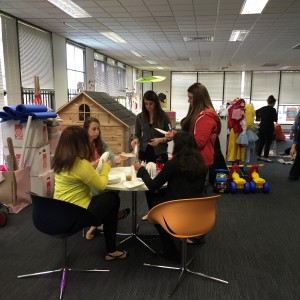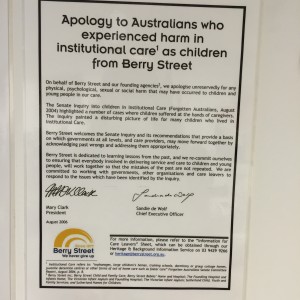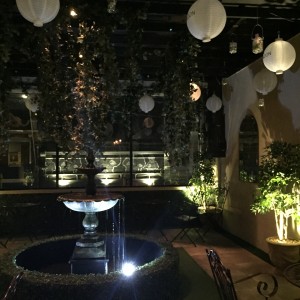The past week in Melbourne was bitter sweet. While we enjoyed visiting the last four agencies on our agenda and learning about the services they had to offer, it was hard to say goodbye to the city that was home for three weeks and to the people we have come to know as close friends. While many of us are traveling on, the main part of our Australia adventure is now complete, leaving us with great memories and insight to reflect on.
One agency that was of particular interest to me (Laura) was the Bouvarie Centre. Having a background in psychology, I was really excited to visit a mental health agency and learn about their family approach to children’s mental health care. I found it interesting to learn about the history of Bouvarie and the fight to turn it into the family-focused agency it is today. I liked that we talked about other systems potentially involved in a child’s life that would affect their care instead of focusing only on the family system. While the family is obviously an important factor, I liked that Jeff mentioned that they look into all the factors in a young person’s life as they all work together to make an individual who they are. Therefore, it is important to have an understanding of the various systems and how they impact one another in order to treat a person successfully. Discussing this approach to practice brought me back to the many social work classes I took this past year learning about the importance of just such an approach.
While I appreciated Jeff’s insight using a multi-system approach and the overview of the center and its history, what I valued the most out of the day’s visit was the time spent discussing the single session therapy approach. This concept was completely new to me as it seems we have spent time in class learning about therapy and treatment methods with the assumption that we would spend multiple sessions with one client. However, Jeff shared some surprising statistics with us that contradicted this idea. He said that a majority of people who seek out therapy only attend one session. What really shocked me about this is that of those who only attend one session, 75% feel were happy with the session and feel like it helped. Jeff’s argument, therefore, was that we need to conduct our therapy sessions with clients as if it will be there only one, and with this new information, I couldn’t agree more.
These statistics along with the advice Jeff gave about conducting a single session therapy appointment have changed my views on mental health treatment. If the clients have more say in the direction of a session, more than likely they will get the greatest benefit from it which is ultimately what a therapist’s goal should be – to help a client the best they can. Even though most people do not return for a second session, I liked that the Bouvarie Centre allows them to come back for services at any point. This ensures people have a place to come for help when they need it, and if the first session is successful in helping them, they will be more likely to utilize such a service in a time of need. One factor the group kept returning to on the trip that makes this access to care easier than it is in the States is universal health care. All of the many services offered at Bouvarie are free which greatly simplifies a child and family getting the necessary mental health resources. While we are a long way from making this a possibility in the U.S, learning about the relative ease of access Australians have to medical resources (and mental health resources) has made me more critical of the American system.
As Laura pointed out, our last week in Melbourne was emotional to say the least. Emotional to see friends go and surprisingly emotional at our agency visits as well. Personally, my (Elena) experience at VICSEG was conjured unexpected feelings. To back track a bit, VICSEG stands for Victorian Cooperative on Children’s Services for Ethnic Groups. This social service agency aims to help refugees and other immigrants adjust to life in Australia and get their lives settled comfortably in a new country. I deduced that simply from the introduction by Janet and John that this day would remind me a lot of my family, specifically my parent’s journey to America. And it did. Although my parents were not refugees from Lebanon, they did immigrant due to conflict and war and have been in the U.S for over half their lives now. It surprises me how detached they have become from their childhood and young adult life in Lebanon. Not to say that those memories aren’t still there, but I know and they know that their lives are here now. That’s easy to say now but not a day goes by during these three weeks that I don’t remind myself of why I’m here in Australia living what once seemed like an impossible dream—it’s because of Mum and Dad. Their hard work, determination, resilience, and love have gotten them through thick and thin.
W ith a lack of U.S education and money, they have obtained a life for each other, my siblings and I, and their direct family. After watching the film at VICSEG, these were the thoughts and memories I had floating through my mind. Those thoughts broke through in the form of tears I couldn’t hold back any longer. Saying I could relate to the families in the film is a very far stretch because my parents (from what I know of) and my siblings and I have never had it that hard. Nothing in the realm of it. But luxuries, vacations, being job free as a teenager weren’t in the cards for my family. Every day is work. And when you’re your own boss, in the case for my parents, work is from sunrise to sunset. That effort is something I never take for granted and is what I’m grateful for having instilled in me growing up. I look at my experience and don’t take anything for granted and capitalize on every opportunity. That is what I find refugees and all immigrants can relate to. Life being hard and knocking you down but getting back up and working even harder for even just a glimpse at a better life. The services VICSEG implements to support these people and their children is extraordinary, especially with how diverse Australia is. Transitioning to what feels like a whole new world is unimaginably difficult, and having even one person let alone an entire social service agency dedicated to helping you along on your new journey is remarkable. And for that alone, I appreciate and respect what VICSEG does for the state of Victoria.
ith a lack of U.S education and money, they have obtained a life for each other, my siblings and I, and their direct family. After watching the film at VICSEG, these were the thoughts and memories I had floating through my mind. Those thoughts broke through in the form of tears I couldn’t hold back any longer. Saying I could relate to the families in the film is a very far stretch because my parents (from what I know of) and my siblings and I have never had it that hard. Nothing in the realm of it. But luxuries, vacations, being job free as a teenager weren’t in the cards for my family. Every day is work. And when you’re your own boss, in the case for my parents, work is from sunrise to sunset. That effort is something I never take for granted and is what I’m grateful for having instilled in me growing up. I look at my experience and don’t take anything for granted and capitalize on every opportunity. That is what I find refugees and all immigrants can relate to. Life being hard and knocking you down but getting back up and working even harder for even just a glimpse at a better life. The services VICSEG implements to support these people and their children is extraordinary, especially with how diverse Australia is. Transitioning to what feels like a whole new world is unimaginably difficult, and having even one person let alone an entire social service agency dedicated to helping you along on your new journey is remarkable. And for that alone, I appreciate and respect what VICSEG does for the state of Victoria.













 At VICSEG, they recognize the struggles and the hardships that refugees and immigrants face when coming to a new country. They may struggle with not only the language, but also cultural norms and even simple things such as how to purchase items at the grocery store. In class, many of us have learned of the hardships in theory, but to solidify our understanding VICSEG played us a video following the refugee stories of two families on their way to Australia. One family coming from a dirty refugee camp in Burma was use to not having electricity and struggling for food. The other family was coming from Africa to reunite with their eleven-year-old daughter, Lily, who was separated from them as an infant during war. None of us, including some of the workers, guessed how this video would make us feel inside. Until this point, too, we had not realized how diverse our own group of fourteen was as well- we have two students with Italian heritage, a student with parents from India, one student from Vietnam, a student with a Lebanese father and Parisa’s father is from Iran. The video hit Parisa close to home because it reminded her of her Papa and him moving to the United States alone in the 1970s during the Iranian Revolution. He moved to America without a firm understanding of the language and also experienced several bouts racism. Though we all became very emotional, there was a great silver lining: the families on the screen and our families had all shown enormous amounts of resilience.
At VICSEG, they recognize the struggles and the hardships that refugees and immigrants face when coming to a new country. They may struggle with not only the language, but also cultural norms and even simple things such as how to purchase items at the grocery store. In class, many of us have learned of the hardships in theory, but to solidify our understanding VICSEG played us a video following the refugee stories of two families on their way to Australia. One family coming from a dirty refugee camp in Burma was use to not having electricity and struggling for food. The other family was coming from Africa to reunite with their eleven-year-old daughter, Lily, who was separated from them as an infant during war. None of us, including some of the workers, guessed how this video would make us feel inside. Until this point, too, we had not realized how diverse our own group of fourteen was as well- we have two students with Italian heritage, a student with parents from India, one student from Vietnam, a student with a Lebanese father and Parisa’s father is from Iran. The video hit Parisa close to home because it reminded her of her Papa and him moving to the United States alone in the 1970s during the Iranian Revolution. He moved to America without a firm understanding of the language and also experienced several bouts racism. Though we all became very emotional, there was a great silver lining: the families on the screen and our families had all shown enormous amounts of resilience.





 believe it would have been for the returning soldiers as well. Breathing in the fresh air that one can only find in the countryside was also rejuvenating, and I hope that this, along with the incredible scenery and the satisfaction of completing a hard day’s work would have helped the soldiers move on with their lives after World War I.
believe it would have been for the returning soldiers as well. Breathing in the fresh air that one can only find in the countryside was also rejuvenating, and I hope that this, along with the incredible scenery and the satisfaction of completing a hard day’s work would have helped the soldiers move on with their lives after World War I.


























